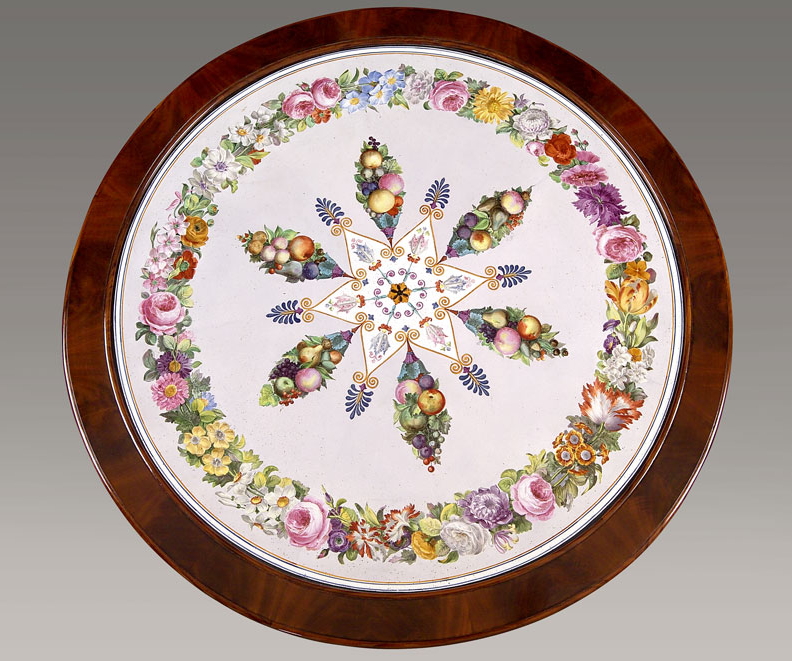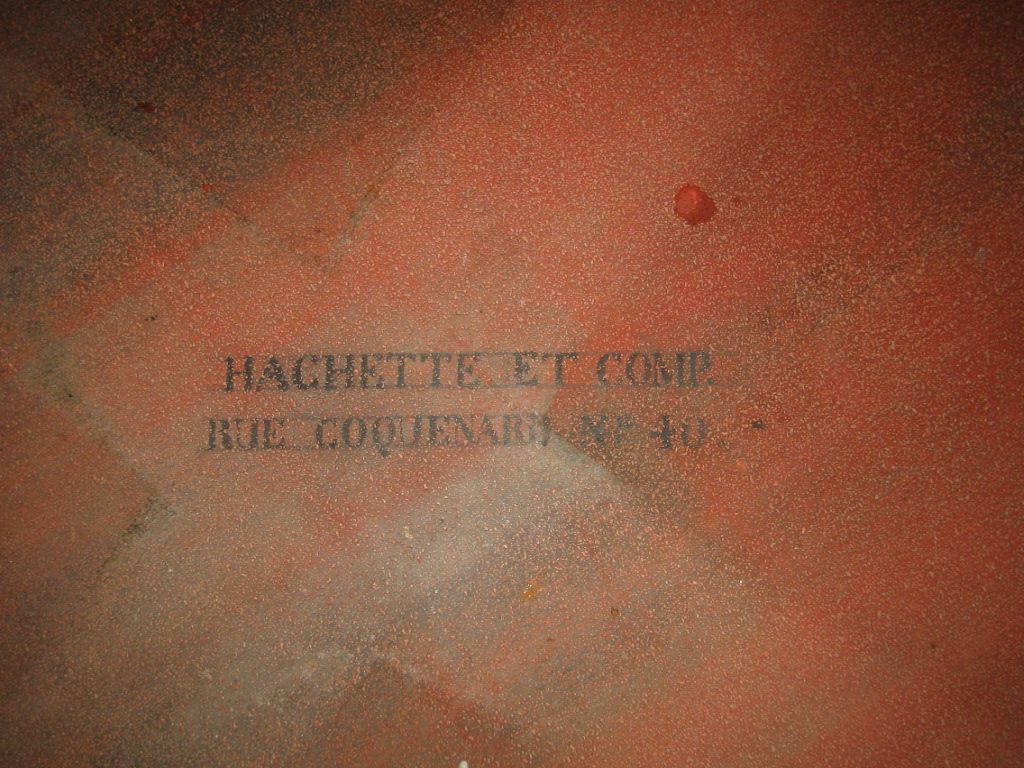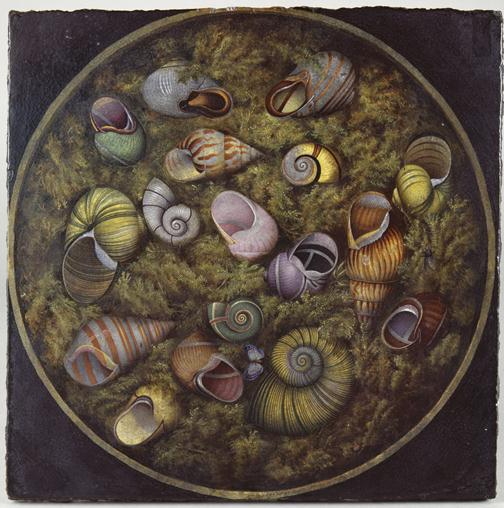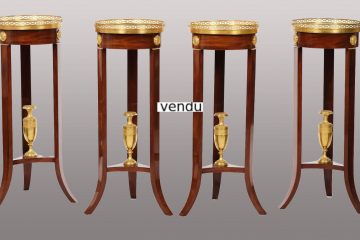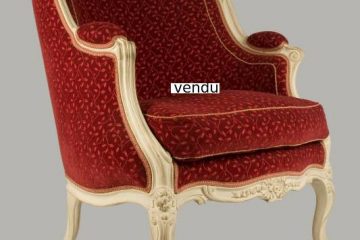
H : 0,74m / 11in ½ diam: 0,93 cm / 14 in 1/2
Ce rarissime guéridon à fût central orné dans la partie basse de petites palmettes en bronze patiné repose sur un pied tripode. Le plateau est orné d’une somptueuse plaque de lave émaillée à fond rosé, à décor de fleurs et de guirlandes de fleurs polychromes. Cette plaque est sertie d’un bandeau en acajou.
Très peu de témoignages de cette technique nous sont parvenus, elle fut pourtant louée dès sa mise en œuvre pour son rendu parfait et inaltérable.
Hachette et Cie
Pierre Hachette qualifié de peintre sur lave et sur porcelaine demeurait rue du Faubourg Saint Martin n°124 lors de son décès le 9 novembre 1847. Comme il est de tradition lors du décès d’un artisan, il est fait un inventaire de son fonds de commerce et dans le cas de Pierre Hachette l’évaluation du fonds est très intéressante puisqu’il est dit la chose suivante: » les experts invités à donner leur avis, son estimation à fixer pour le fonds de commerce de peintre sur lave et sur porcelaine dont le matériel vient d’être ci-devant inventorié et déclaré que l’industrie de M. Hachette consistait uniquement dans l’exploitation d’un procédé artistique et purement personnel qu’en conséquence elle n’était susceptible d’aucune évaluation » .
Pierre Hachette s’était marié avec Adélaide Marie Dubois qui n’était autre que la fille de Ferdinand Henri Joseph Mortelecque, chimiste demeurant Faubourg Saint Martin n° 132 (décédé le 12 août 1842). La comte Chabrol de Volvic, ingénieur des Ponts et Chaussées (1773 – 1843), très intéressé à vouloir favoriser l’industrie de sa région, appuyé par le préfet, tous deux s’intéressèrent aux travaux de
Ferdinand Mortelecque qui depuis longtemps se penchait sur les techniques de l’émail. Il mit au point une technique de peinture à l’émail sur lave dans les années 1827-28. Elle reposait sur une double cuisson: la plaque de lave revêtue d’une première couche de peinture passa au four, sur ce fond qui joue le rôle d’une préparation, les couleurs sont posées et la plaque subit une seconde cuisson.
Par cette application d’un émail durable sur la lave, une carrière nouvelle s’ouvrait pour la peinture monumentale: C’est l’église Notre Dame de Lorette en 1834 qui est ornée de ces plaques sur les autels, suvie par le décor apposé sur sa façade derrière la colonnade de l’église Saint Vincent de Paul.
Cette même année 1834, le rapport « du jury central sur les produits de l’industrie française » donne une médaille d’argent à M Hachette-Hittorff et Cie à Paris, rue Coquenard n°40, disant: » l’art dont nous venons de signaler l’importance après un grand développement entre les mains de M. Hachette, gendre de M. Morteleque, auquel ce dernier a cédé l’exploitation. M. Hachette a soumis à l’exposition une belle collection de meubles et d’ornements en lave émaillée, peints d’après des procédés que nous venons d’indiquer et d’après les dessins de M. Hittorff, directeur de cette nouvelle fabrication« .
Le 40 de la rue Coquenard (qui deviendra la rue Lamartine en 1848) est l’adresse de Jacques Ignace Hittorff, architecte, membre de l’institut, adresse où il décède le 25 mars 1867.
En 1848, la veuve Hachette confie la direction de l’entreprise à François Gillet, et la fermeture définitive de l’entreprise interviendra en 1869.
La technique de la lave émaillée
En 1791, le premier brevet français concernant la peinture sur lave et déposé par Louis-François Ollivier, céramiste de métier. On peut considérer que c’est lui qui a eu l’idée d’émailler les roches.
C’est aussi à cette époque que naît un marché: l’identification des rues de Paris.
En 1827 et 1828 beaucoup de brevets sont déposés sur le sujet de la lave émaillée, mais aucun n’apporte un plus sur le plan technique.
En 1828, il est décidé d’adopter la lave émaillée pour les plaques des rues de Paris et ce premier marché fut attribué à l’entreprise Hachette.
L’exploitation des carrières d’andésite du volcan de la Nugère, situées à proximité du village de Volvic est très ancienne, mais sa notoriété date du milieu du 13e siècle avec l’édification de la cathédrale de Clermont-Ferrand. Facile à tailler, très résistante, elle peut être débitée en grandes dimensions, d’où son utilisation pour les arts décoratifs.
Pour la décoration d’une plaque comme celle-ci, on crée un dessin au crayon directement sur la plaque de lave. Lorsqu’on dépose ensuite l’émail au pinceau ou à la poire, il est arrêté par le carbone, ce qui permet de délimiter des zones de couleurs différentes. Appliquée sur un fond d’émail déjà cuite, cette technique permet de créer des décors au pinceau de manière plus fine que le cloisonné. Les couleurs vitrifiées ont un rendu proche d’une peinture, la résistance en plus.
Un panneau en lave émaillé présenté à l’exposition des Produits de l’Industrie en 1834 fait dire à un journaliste: » la peinture émaillée sur lave laisse peu à désirer quant à la perfection matérielle, et il semble impossible de donner aux couleurs plus d’éclat , à la matière plus de solidité, puisque ces deux qualités résultent nécessairement, l’une de la vitrification de l’ émail, l’autre de l’intensité d’un feu soutenu pendant plusieurs jours à l’état d’incandescence »;
Alexandre Brogniart, en train de constituer le musée de la céramique, souhaita avoir des échantillons de ce matériau. C’est ainsi que l’architecte Hittorff offrit un plateau de table dans le style gothique. Un autre plateau orné de coquillage, œuvre de Ferdinand Morteleque, exposé en 1827 figure aussi dans les collections du musée national de la Céramique.
